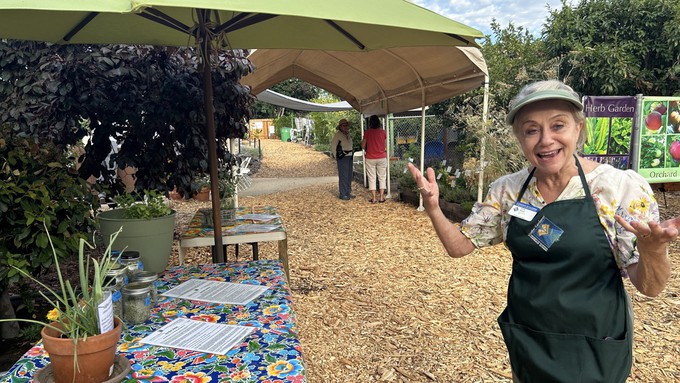
Training program starts in winter; deadline to apply is Oct. 10

Master gardener Anita Brown, from the Sacramento County class of 2020, welcomes visitors to the Fair Oaks Horticulture Center on Harvest Day. Applications for the 2025 class will open Sept. 10. Kathy Morrison
Being a UC master gardener does not mean having a gardening encyclopedia for a brain.
But a master gardener does relish talking about plants and gardening: asking or answering questions, sharing skills, diagnosing problems and always being interested in learning more.
Does this sound like you or someone you know? Here's the chance, for residents of Sacramento County: Applications for the 2025 UC master gardener training class open Sept. 10.
Sacramento County’s master gardener program does not train every year; the class of 2023 is the most recent one. Applicants must be residents of Sacramento County; other counties have their own training programs.
The application period closes Oct. 10. Informational “Meet the Master Gardeners” events typically are held in the fall; dates are not yet set. The fee for the 2025 training program also has yet to be announced.
Master gardeners are volunteers who educate the public via workshops, home and garden events, festivals, talks to community groups, and the Cooperative Extension's online and phone Help Desk, sharing UC research-based home horticultural information. They are especially visible at the State Fair information booth and at the Fair Oaks Horticulture Center, Sacramento County's demonstration garden. (Check them out at the next Open Garden at the FOHC, on Sept. 14.)
The training program generally starts in January and runs into May. Classes typically meet once a week, all day, and are taught by a variety of university specialists, horticulture advisers and community experts.
New master gardeners are required to put in 50 hours of volunteer time the first year; veterans have a 25-hour annual requirement. Twelve hours of continuing education per year also is required for all master gardeners.
Hint from me, a member of the 2020 class: Folks with a history of or interest in volunteering in any capacity -- church, school, community, whatever — do very well. People skills are important. It also helps if you enjoy a good research hunt. As my class was told, “We don’t expect you to memorize everything, but we expect you to know where to look it up.”
More information on the training program is here: https://sacmg.ucanr.edu/Master_Gardener_Training/
Comments
0 comments have been posted.Sacramento Digs Gardening to your inbox.
Food in My Back Yard Series
April 29: What's (already) wrong with my tomato plants?
April 22: Should you stock up on fertilizer? (Yes!)
April 15: Grow culinary herbs in containers
April 8: When to plant summer vegetables
April 1: Don't be fooled by these garden myths
March 25: Fertilizer tips: How to 'feed' your vegetables for healthy growth
March 18: Time to give vegetable seedlings some more space
March 11: Ways to win the fight against weeds
March 4: Potatoes from the garden
Feb. 25: Plant a fruit tree now -- for later
Feb. 18: How to squeeze more food into less space
Feb. 11: When to plant? Consider staggering your transplants
Feb. 4: Starting in seed starting
Sites We Like
Garden Checklist for week of April 27
Once the clouds clear, get to work. Spring growth is in high gear.
* Set out tomato, pepper and eggplant transplants.
* From seed, plant beans, beets, cantaloupes, carrots, corn, cucumbers, melons, pumpkins, radishes and squash. Plant onion sets.
* In the flower garden, plant seeds for asters, cosmos, celosia, marigolds, salvia, sunflowers and zinnias. Transplant petunias, zinnias, geraniums and other summer bloomers.
* Plant perennials and dahlia tubers for summer bloom. Late April is about the last chance to plant summer bulbs, such as gladiolus and tuberous begonias.
* Transplant lettuce and cabbage seedlings.
* Weed, weed, weed! Don’t let unwanted plants go to seed.
* April is the last chance to plant citrus trees such as dwarf orange, lemon and kumquat. These trees also look good in landscaping and provide fresh fruit in winter.
* Feed citrus trees with a low dose of balanced fertilizer (such as 10-10-10) during bloom to help set fruit. Keep an eye out for ants.
* Apply slow-release fertilizer to the lawn.
* Thoroughly clean debris from the bottom of outdoor ponds or fountains.
* Start thinning fruit that's formed on apple and stone fruit trees -- you'll get larger fruit at harvest (and avoid limb breakage) if some is thinned now. The UC recommendation is to thin fruit when it is about 3/4 of an inch in diameter. Peaches and nectarines should be thinned to about 6 inches apart; smaller fruit such as plums and pluots can be about 4 inches apart. Apricots can be left at 3 inches apart. Apples and pears should be thinned to one fruit per cluster of flowers, 6 to 8 inches apart.
* Azaleas and camellias looking a little yellow? If leaves are turning yellow between the veins, give them a boost with chelated iron.
* Trim dead flowers but not leaves from spring-flowering bulbs such as daffodils and tulips. Those leaves gather energy to create next year's flowers. Also, give the bulbs a fertilizer boost after bloom.
* Pinch chrysanthemums back to 12 inches for fall flowers. Cut old stems to the ground.
* Mulch around plants to conserve moisture and control weeds.